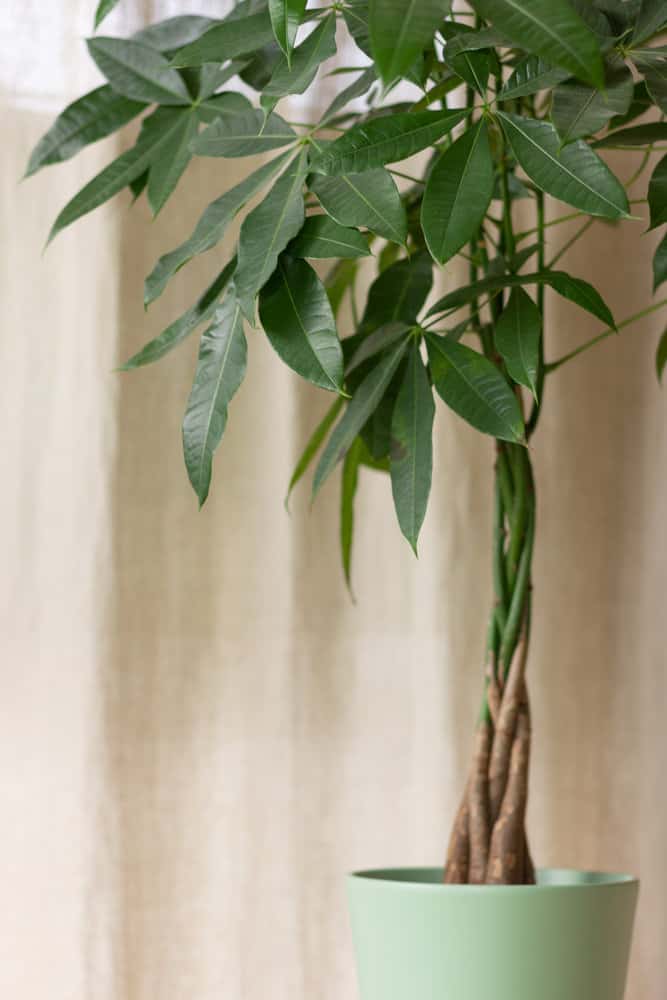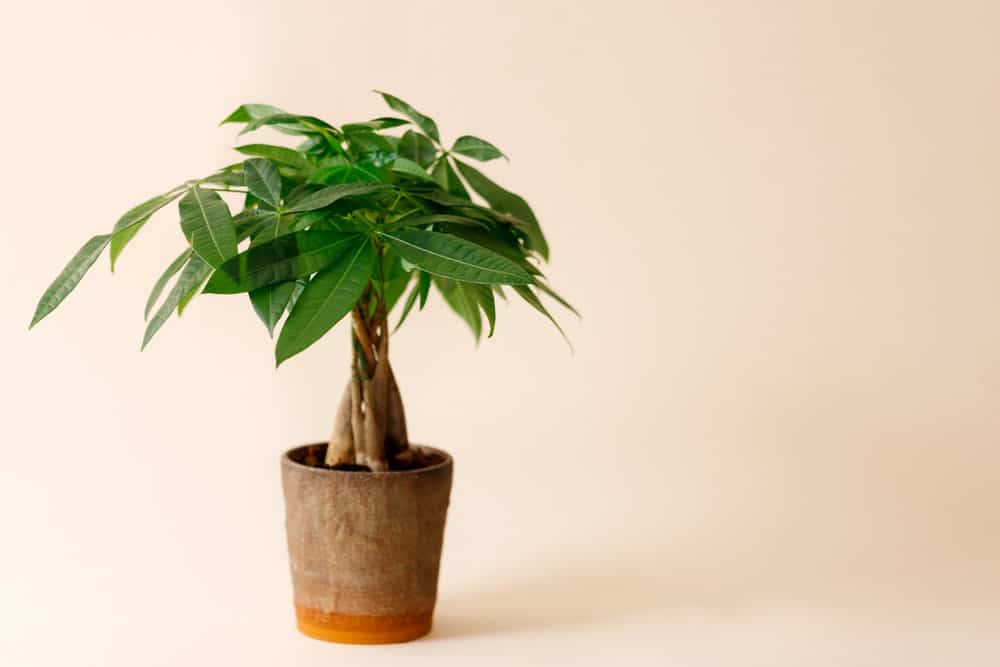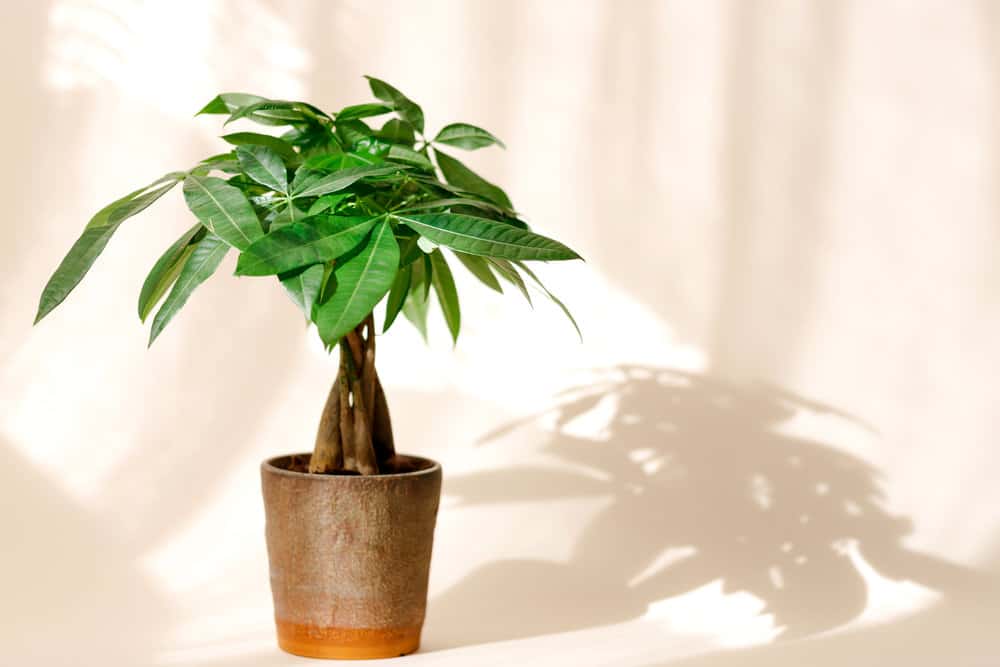We can name hundreds of reasons to have plants in your home, from improving your health to making your space more vibrant and beautiful. But did you know that some plants can bring good luck and prosperity to your home?
Yes, certain plants, including the money tree, are associated with good luck and positive energy. And although the money plant is easy to care for, it takes more than luck to keep it happy and healthy.
Let’s discuss money plants, including what they are, how to care for them, the common problems facing these plants, etc.
Let’s get started!

What is a money plant?
Also known as the money tree – or the scientific name Pachira Aquatica – the Chinese money plant (its common name) is a tree species whose native habitat is Mexico and central and south America. The plant features dark green leaves, and braided trunks, making it perfect for indoor spaces.
The money plant is commonly grown in Taiwan and Hawaii and is often used as a bonsai tree. The plant can get as tall as 60 feet but will grow to 3-6 feet indoors.
The plant is a perfect gift for baptisms, birthdays, anniversaries, housewarmings, and bar mitzvahs because it is believed to help people prosper. Similarly, the money tree is an incredibly lush green plant that adds vibrancy to your room, making it ideal for Feng Shui.

Can I plant the money tree outside?
The money tree is an evergreen plant that brings good fortune and prosperity to any space. But can you plant these trees in the outdoor space?
The answer is yes: you can grow money plants outside, provided it’s subjected to the right weather conditions. If you plant this tree outdoors, be sure to bring it inside before the temperature drops to 40 degrees F or below.
Outdoors, the money plant can grow anywhere from under the sun to in partial shade. However, be extra careful when you move them from inside the house to outdoors under the full sun, as leaves will burn.
Also, if you choose to grow the money tree outside, ensure you place it in a pot with drainage holes so it doesn’t drown when it rains.
How should I care for money plants?
Like other plants, the money tree needs proper care to prosper and stay healthy. From water requirements to sunlight, here is how you care for the money tree:
Ideal temperatures
The money tree grows well in a mix of direct and indirect sunlight. Like other popular houseplants, too much direct sunlight can scorch the leaves and kill your plant.
To strike the right balance for your money plant, rotate or turn it regularly for even light distribution. But don’t move it all over the place as that would disturb it too much.
Humidity requirements
Humidity is another important factor determining your house plant’s success, especially during the winter months. Heating out homes during these cold months depletes humidity out of the air and can be sensitive to tropical plants, including money plants.
You can increase the humidity level around your money plant using several methods. For instance, you can run a humidifier near the plant or place it on a pebble tray full of water (don’t leave the plant to sit in the water for long, though).
Feeding your plant with lots of water can lead to root rot and will probably kill your plant.
You can also create a mini indoor greenhouse or grow your money tree in a small plant cloche, adding a decorative element to your home. Keep an indoor air moisture monitor nearby to help maintain the right humidity level.

Repotting frequency
You should repot your money plant into fresh soil every few years to boost its growth and maintain its health. The best time to repot your plant are in early summer and spring.
Ensure you choose the right-sized container when repotting your money tree plant. Don’t use a pot that’s too large, as that can lead to overwatering and root rot problems.
You can grow the money tree plants in very small pots, especially if you want to keep their size manageable. So, when repotting, choose a container that’s only a little bit larger than the one it was planted into.
The rule of the thumb is to use a potting container with a diameter wide enough to fit the plant’s foliage. If you plan to plant your money tree outdoors, plant it under the shade of large trees with good drainage soil.
Water your plant
Proper watering is among the best care tips for money plants. They thrive with ample watering and won’t tolerate wet soil for a long time – overwatering will result in root rot and can kill your plant.
Check on your money tree plants every week or two to see how wet the soil is. Let the soil to dry slightly before re-watering – don’t leave it to dry out completely, however.
When watering, give the plant adequate drink, and let the excess water drain from the drainage holes in the bottom of the pot. Ensure to empty the drip tray or cache pot so that the container isn’t sitting in the water.
The money tree plants don’t require much watering during winter as in the summer months, so you can leave the soil to dry out a little more. If you struggle to give your plant the correct water, you can consider buying a soil moisture gauge.
Soil mix
The money tree plant thrives in well-drained soil so you can give it a mixture of sand and the normal potting soil. River sand is perfect for aeration and drainage, meaning your plant will prosper well.
You can also use potting soil with high pearlite content – such as the one used for cacti plants. But the money tree loves nutrient-rich soil, so a peat moss-based soil mix is also perfect. Slightly acidic or pH-neutral soil offers the ideal conditions for this popular indoor plant.

Fertilizing money plants
You may also feed your money tree with fertilizer to boost its growth and health. Any basic liquid houseplant fertilizer can work for the plant, but you should dilute it to half the recommended strength.
You can feed the money plant as infrequently as once in mid-summer and once in early spring, but a recommended frequency is once a month throughout its growing season. Most climates will allow you to skip fertilizing the money plant during winter.
You can use the compost tea for the best results. Compost tea bags soaked in water offer a controlled dose of nutrients for the development of your plant.
This natural fertilizer also enhances the potting soil by rebuilding its microbial populations.
Use Bonsai slow-release fertilizer if your plant has droopy and yellow leaves. Other fertilizers such as Jobe’s Houseplant Food Spikes offer your plants various nutrients, including potassium, nitrogen, phosphorus, etc.
Prune your money tree plant
Generally, the money tree plant doesn’t need trimming, but regular pruning helps keep it smaller. New leaves grow very quickly, which is why it’s so appealing and attractive for bonsai.
To prune your money tree plant, trim or pinch off the tips of the new growth. This activity also enhances branching, making it shapelier.
Use micro-tip snip and bonsai shears for precision and sharp cuts. It’s recommended that you prune your trees in summer or spring when new growths are surefire to sprout out.
What are the common money plant problems?
Like most plants, money tree plants face several challenges, including pests and diseases. Let’s go through some of these problems.
Pests
The money plant is susceptible to several insects, including spider mites, aphids, white flies, scale insects, and mealybugs. Most of these pests will drain your plant’s moisture by sucking the sap out of it.
The bugs love the phloem sap produced by the money plant, and their activity often leads to yellowing foliage. To eradicate the pests, use high humidity levels around your plant or use neem oil or insecticidal soap.
You can also isolate the infested plant and treat it with the right pest control method.
Diseases
The money tree plant is susceptible to several diseases, including Rhizoctonia root rot, bacterial wilt disease, manganese toxicity, etc. Learning the cause of each disease is key to helping save your plants.
For instance, root rot occurs when you leave the plant in soggy soil or overwater it. Reducing how much water you feed your plant can help avoid root rot and save your plants. Prune the dead leaves to improve your plant’s appearance.
How much does the money plant cost?
The money tree plant cost varies depending on its size, but the price ranges anywhere from $15 or more. You can purchase the plant online or from your local garden center.
The money plant is fun and rewarding despite the price you get it for.
The bottom line
Whether you are superstitious or not, I’m sure you’d want a little luck in your life – and your house. For this reason, you’ll see some people with fake rabbit feet, turtle curving, and vulture heads in their homes.
Adding money plants to your home can also bring some luck while improving its appearance. This post takes you through everything you need to know about money tree plants, including what they are, how to care for them, etc.
Good luck as you use it to bring some luck to your home with this popular houseplant!
Leave a Reply